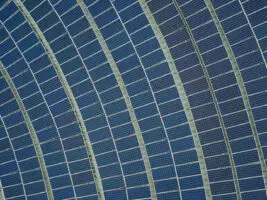Another of the world’s leading solar PV manufacturing giants has underlined the potential for yet more substantial falls in the manufacturing cost of solar modules, even as the cost of fossil fuels – and gas in particular – surges in the opposite direction.
Beyond the near-term revenue forecasts that obsess market analysts, one of the big take-outs of First Solar’s annual market day in New York this week was its predictions about the cost of solar modules over the next five years.
In short, First Solar expects its average manufacturing cost to nearly halve – from an average $US0.63/watt in 2013, to $US0.35/W in 2018. That will bring the total installed cost of a module (including racking and inverters) from around $1.59/W to below $1/W by 2017 – so meeting the US Department of Energy’s ambitious Sunshot Initiative goals at least three years ahead of time.
This is significant because as solar prices are coming down, fossil fuel prices are headed quickly in the opposite direction. The US has been hailed as the nation of cheap gas, but that is proving to be an illusion betrayed by rapid depletion rates of wells and the growing challenge of deeper and more complicated reserves. Not to mention the water and other environmental considerations.
 As this story from EnergyWire states, wholesale prices in the north-east grid in the US jumped 55 per cent in 2013, thanks mostly to a 76 per cent jump in the price of gas to $US6.97/MMBTU, which is now back above its pre GFC, pre-fracking boom levels. (Bookmark the graph, and point it out to the next person that tells you how the fracking boom has guaranteed low electricity prices into the future. It’s bunkum).
As this story from EnergyWire states, wholesale prices in the north-east grid in the US jumped 55 per cent in 2013, thanks mostly to a 76 per cent jump in the price of gas to $US6.97/MMBTU, which is now back above its pre GFC, pre-fracking boom levels. (Bookmark the graph, and point it out to the next person that tells you how the fracking boom has guaranteed low electricity prices into the future. It’s bunkum).
The future of large-scale solar was in balance just a year ago, mostly because many of the initial big projects had been funded by California’s ambitious renewable energy target, and a strong solar mandate.
But First Solar now sees this large-scale market rebounding, mostly because interest is turning to solar because of those rising gas prices. Power purchase agreements, according to Deutsche Bank analysts, are in the range of $US50-$US70/MWh (helped by a tax credit because the LCOE of most utility scale solar is still probably abov $100/MWh.
Solar companies are meeting those PPA prices – not making a whole lot of profit, but with costs to come down as dramatically as SunPower, SunEdison and First Solar have suggested, they are making enough to secure their future. Gas developers can simply no longer compete because the forward gas prices are pushing gas generation costs well beyond this.
First Solar is finding particular interest in the 20-50MW project size, which many utilities think will address their issues about daytime peaks. These offer lower execution risk for the likes of First Solar and offer the company the ability to improve overall cost of capital through a potential “yieldco” transaction (floating off projects into a new high yield company).
Note: The gas problem is also true in Australia, but because there is effectively no policy for a carbon price and no emissions standards on coal-fired power generation under the new Abbott conservative government, coal generation will be allowed to grow, particularly as the renewable energy target is wound back, and incentives for large-scale solar are diminished. The costs of large-scale solar are much cheaper in the US than Australia – not because the modules are any cheaper – but because the balance of systems costs are so much cheaper because they have built so many. Australia, to date, has just one 10MW solar plant completed.
But back to First Solar. The keys to its cost reductions are several. The first is the lift in conversion efficiency. This recently hit a high of 17.2 per cent for its cadmium telluride thin-film panels, and will increase to 19.5 per cent by 2017.
The balance of system costs which had previously put it at a disadvantage to silicon-based solar PV may soon put it at an advantage. And First Solar is about to announce major savings as part of its partnership with General Electric, which is looking at an even cheaper and more efficient utility-scale solar power plant design, and it has also purchased its own silicon-based manufacturing facility in Thailand.
It was interesting to note that Deutsche Bank analysts thought that the market were generally discounting these broader trends and focused – as it its want – on the near term financial numbers. Deutsche, however, was sufficiently encouraged by the potential for aggressive efficiency/cost roadmap, it had lifted its target price for the stock from $US50 to $US70.
This graph below is interesting. It shows just how small a role that module prices play in the ultimate cost of the technology. Two thirds of the costs are related to items that can only be reduced by deployment. This is important to note because it explains why the incumbents try everything to stop further development, and hold on to the nonsense sprouted by the likes of fossil fuel pin-up boy Bjorn Lomborg that R&D is the only solution to cost reductions.
This last graph shows First Solar’s estimation of the solar market in 2016. Interestingly, while it sees a resurgence in big utility-scale mandates, it recognises also that half the market comes in the household and commercial-scale market, which is mostly rooftop.
CEO Jim Hughes told the analysts that the company now believes it can compete for that rooftop market – something it had largely abandoned previously. It says it is competing for 15 commercial projects totaling MW, and is “shortlisted” for MW of those.
Hughes says the company is also targeting sales of panels to mine operators in remote areas and other industries that currently rely on diesel generators. Australia is one of those targets. At one location (not Australia), First Solar installed 10MW of solar panels to accompany 15.3MW generated by a diesel-fuelled generator.










